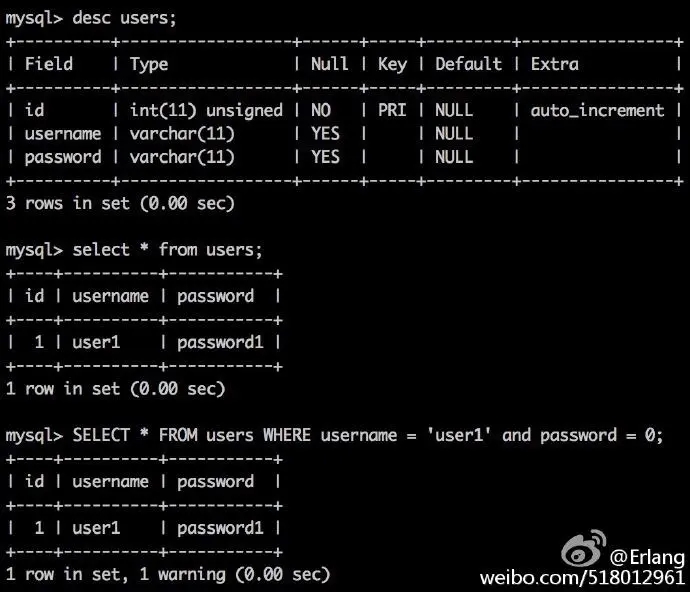mysql中的隐式转换总结
在mysql查询中,当查询条件左右两侧类型不匹配的时候会发生隐式转换,可能导致查询无法使用索引。下面分析两种隐式转换的情况。
第一种情况:索引字段是varchar类型
select * from user where index_filed=2;
因为等号两侧类型不一致,因此会发生隐式转换,cast(index_filed as signed),然后和2进行比较。因为'2',' 2','2a'都会转化成2,故MySQL无法使用索引只能进行全表扫描,造成了慢查询的产生。
第二种情况:索引字段是int类型
select * from user where index_filed='2';
这次等号右侧是'2',注意带单引号哟,左侧的索引字段是int类型,因此也会发生隐式转换,但因为int类型的数字只有2能转化为'2',是唯一确定的。所以虽然需要隐式转换,但不影响使用索引,不会导致慢查询。
问题如下下所示

问题描述
where 条件语句里,字段属性和赋给的条件,当数据类型不一样,这时候是没法直接比较的,需要进行一致转换
默认转换规则是:
①:不同类型全都转换为浮点型(下文都说成整型了,一个意思)
②:如果字段是字符,条件是整型,那么会把表中字段全都转换为整型(也就是上面图中的问题,下面有详细解释)
转换总结:
1:字符转整型
①:字符开头的一律为0
②:数字开头的,直接截取到第一个不是字符的位置
2:时间类型转换
①:date 转 datetime 或者 timestamp 追加 00:00:00
②:date 转 time 无意义,直接为 00:00:00
③:datetime 或者 timestamp 转 date 直接截取date字段
④:datetime 或者 timestamp 转 time 直接截取time字段
⑤:time 转 datetime 或者 timestamp 按照字符串进行截取 23:12:13 -> 2023-12-13(这个后文有讨论)
⑥:cast函数只能转datetime,不能转timestamp
如果按照timestamp来理解,因为timestamp是有范围的('1970-01-01 00:00:01.000000' to'2038-01-19 03:14:07.999999'),所以只能是2023年,而不能是1923年
对于不符合的时间值,如10:12:32等,会变为 0000-00-00 或为 空
⑦:time和datetime转换为数字时,会变为双精度,加上ms(版本不同不一样)
案例分析
表结构,name字段有索引
-- 注意name字段是有索引的
CREATE TABLE `t3` (
`id` int(11) NOT NULL,
`c1` int(11) NOT NULL,
`name` varchar(100) NOT NULL DEFAULT 'fajlfjalfka',
KEY `name` (`name`),
KEY `id` (`id`)
) ENGINE=InnoDB DEFAULT CHARSET=latin1
1 row in set (0.00 sec)
-- 模拟线上一个隐式转换带来的全表扫面慢查询
-- 发生隐式转换
xxxx.test> select * from t3 where name = 0;
+----+----+-------------+
| id | c1 | name |
+----+----+-------------+
| 1 | 2 | fajlfjalfka |
| 2 | 0 | fajlfjalfka |
| 1 | 2 | fajlfjalfka |
| 2 | 0 | fajlfjalfka |
+----+----+-------------+
4 rows in set, 4 warnings (0.00 sec)
-- 上述SQL执行计划是全表扫描,扫描后,字符转整型,都是0,匹配上了条件,全部返回
xxxx.test> desc select * from t3 where name = 0;
+----+-------------+-------+------+---------------+------+---------+------+------+-------------+
| id | select_type | table | type | possible_keys | key | key_len | ref | rows | Extra |
+----+-------------+-------+------+---------------+------+---------+------+------+-------------+
| 1 | SIMPLE | t3 | ALL | name | NULL | NULL | NULL | 4 | Using where |
+----+-------------+-------+------+---------------+------+---------+------+------+-------------+
1 row in set (0.00 sec)
-- 加上单引号后,是走name索引的,非全表扫描
xxxx.test> desc select * from t3 where name = '0';
+----+-------------+-------+------+---------------+------+---------+-------+------+-----------------------+
| id | select_type | table | type | possible_keys | key | key_len | ref | rows | Extra |
+----+-------------+-------+------+---------------+------+---------+-------+------+-----------------------+
| 1 | SIMPLE | t3 | ref | name | name | 102 | const | 1 | Using index condition |
+----+-------------+-------+------+---------------+------+---------+-------+------+-----------------------+
1 row in set (0.00 sec)
-- 走索引,没返回
xxxx.test> select * from t3 where name = '1';
Empty set (0.00 sec)
解释:
如果条件写0或者1,会进行全表扫面,需要把所有的name字段由字符全都转换为整型,再和0或者1去比较。由于都是字母开头的字符,会全都转为为0,返回的结果就是所有行。
那有人问了,为什么不把条件里的 0 自动改成 '0' ?见下文。
转换举例:
-- 字符开头,直接是0
xxxx.test> select cast('a1' as unsigned int) as test ;
+------+
| test |
+------+
| 0 |
+------+
1 row in set, 1 warning (0.00 sec)
xxxx.test> show warnings;
+---------+------+-----------------------------------------+
| Level | Code | Message |
+---------+------+-----------------------------------------+
| Warning | 1292 | Truncated incorrect INTEGER value: 'a1' |
+---------+------+-----------------------------------------+
1 row in set (0.00 sec)
-- 开头不是字符,一直截取到第一个不是字符的位置
xxxx.test> select cast('1a1' as unsigned int) as test ;
+------+
| test |
+------+
| 1 |
+------+
1 row in set, 1 warning (0.00 sec)
xxxx.test> select cast('123a1' as unsigned int) as test ;
+------+
| test |
+------+
| 123 |
+------+
1 row in set, 1 warning (0.00 sec)
-- 直接按照字符截取,补上了20(不能补19)
xxxx.test> select cast('23:12:13' as datetime) as test ;
+---------------------+
| test |
+---------------------+
| 2023-12-13 00:00:00 |
+---------------------+
1 row in set (0.00 sec)
-- 为什么不能转换为timestamp,没搞清楚,官方文档给的转换类型里没有timestamp。如果是这样的话,上面的datetime就不好解释为什不是1923了。难道是检测了当前的系统时间?
xxxx.test> select cast('23:12:13' as timestamp) as test ;
ERROR 1064 (42000): You have an error in your SQL syntax; check the manual that corresponds to your MySQL server version for the right syntax to use near 'timestamp) as test' at line 1
-- 这个时间无法转换成datetime
xxxx.test> select cast('10:12:32' as datetime) as test ;
+------+
| test |
+------+
| NULL |
+------+
1 row in set, 1 warning (0.00 sec)
xxxx.test> show warnings ;
+---------+------+--------------------------------------+
| Level | Code | Message |
+---------+------+--------------------------------------+
| Warning | 1292 | Incorrect datetime value: '10:12:32' |
+---------+------+--------------------------------------+
1 row in set (0.00 sec)
-- 5.5版本下,时间转字符,会增加ms
xxxx.(none)> select version();
+------------+
| version() |
+------------+
| 5.5.31-log |
+------------+
1 row in set (0.00 sec)
xxxx.(none)> select CURTIME(), CURTIME()+0, NOW(), NOW()+0 ;
+-----------+---------------+---------------------+-----------------------+
| CURTIME() | CURTIME()+0 | NOW() | NOW()+0 |
+-----------+---------------+---------------------+-----------------------+
| 15:40:01 | 154001.000000 | 2016-05-06 15:40:01 | 20160506154001.000000 |
+-----------+---------------+---------------------+-----------------------+
1 row in set (0.00 sec)
-- 5.6 不会
xxxx.test> select version();
+------------+
| version() |
+------------+
| 5.6.24-log |
+------------+
1 row in set (0.00 sec)
xxxx.test> select CURTIME(), CURTIME()+0, NOW(), NOW()+0 ;
+-----------+-------------+---------------------+----------------+
| CURTIME() | CURTIME()+0 | NOW() | NOW()+0 |
+-----------+-------------+---------------------+----------------+
| 15:40:55 | 154055 | 2016-05-06 15:40:55 | 20160506154055 |
+-----------+-------------+---------------------+----------------+
1 row in set (0.00 sec)
为什么不把 where name = 0 中的 0 转换为 '0' 答案如下:
如果是数字往字符去转换,如 0 转'0',这样查询出来的结果只能是字段等于 '0',而实际上,表里的数据,如'a0','00',这其实都是用户想要的0,毕竟是用户指定了数字0,所以MySQL还是以用户发出的需求为准,否则,'00'这些都不会返回给用户。
-- 上面遗留的问题,跟系统时间并没有关系。怀疑虽然指定的是datetime,但是内部还是按照timestamp去做的。
mysql> select now();
+---------------------+
| now() |
+---------------------+
| 1999-08-03 14:16:50 |
+---------------------+
1 row in set (0.00 sec)
mysql> select cast('23:12:13' as datetime) as test ;
+---------------------+
| test |
+---------------------+
| 2023-12-13 00:00:00 |
+---------------------+
1 row in set (0.00 sec)
查询示例如下所示:
CREATE TABLE `t_user` (
`id` bigint(100) NOT NULL AUTO_INCREMENT,
`password` varchar(255) DEFAULT NULL,
`name` varchar(255) DEFAULT NULL,
`phone` varchar(11) CHARACTER SET utf8 COLLATE utf8_general_ci DEFAULT NULL,
`age` int(11) DEFAULT NULL,
`nick_name` varchar(255) DEFAULT NULL,
`sex` int(255) DEFAULT NULL,
`birthday` datetime DEFAULT NULL,
`class_id` int(11) DEFAULT NULL COMMENT '班级id',
PRIMARY KEY (`id`),
KEY `index_phone` (`phone`) USING BTREE,
KEY `index_birthday` (`birthday`) USING BTREE,
KEY `index_name` (`name`,`age`) USING BTREE
) ENGINE=InnoDB AUTO_INCREMENT=1588138958133 DEFAULT CHARSET=utf8;
explain select age from t_user where age = '32'; --- 走索引
explain select age from t_user where age = 32; --- 走索引
explain select * from t_user where name = 32; --- 不走索引
explain select * from t_user where name = '32'; --- 走索引
explain select * from t_user where birthday = '2020-09-09'; --- 走索引
explain select * from t_user where DATE_FORMAT(birthday,'yyyy-MM-dd') = '2020-09-09'; ---不走索引
隐式转换如上所示:不要再列上进行函数计算,比如使用date_format函数等,int类型的数值可以是整型或者是字符串类型都是可以的,但是字符串类型的数据的数值必须是字符串,否则会进行全表扫描,不走索引。



 浙公网安备 33010602011771号
浙公网安备 33010602011771号